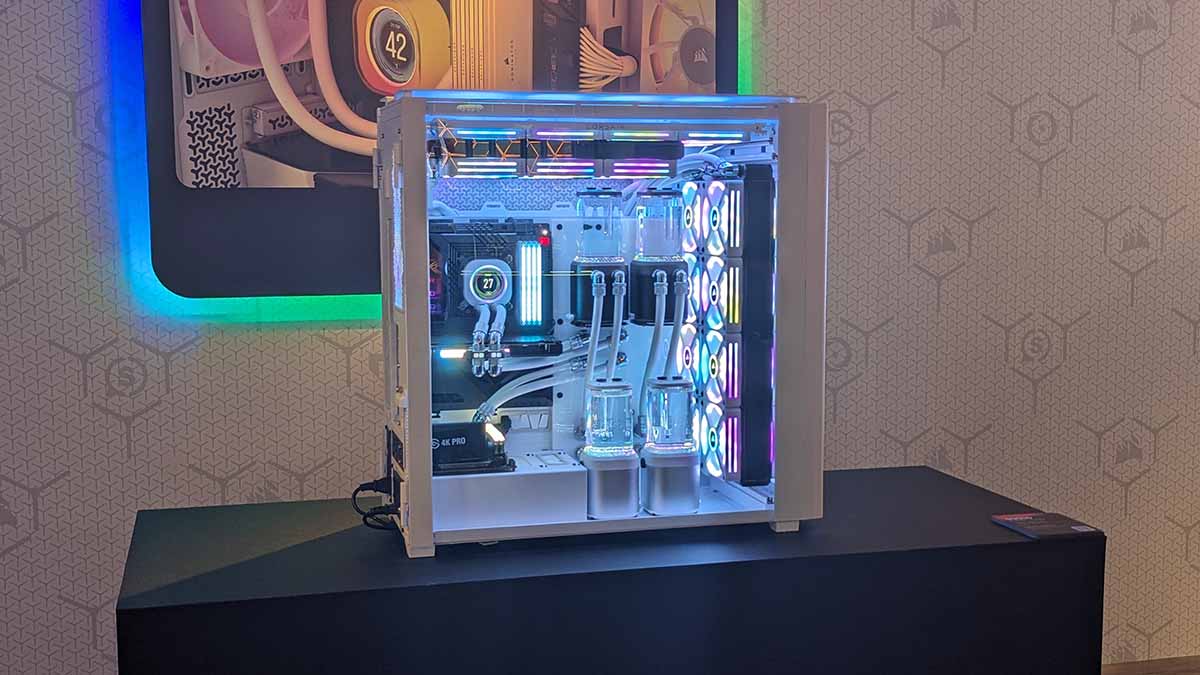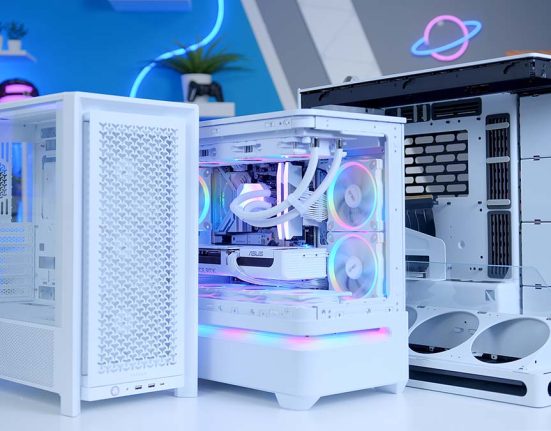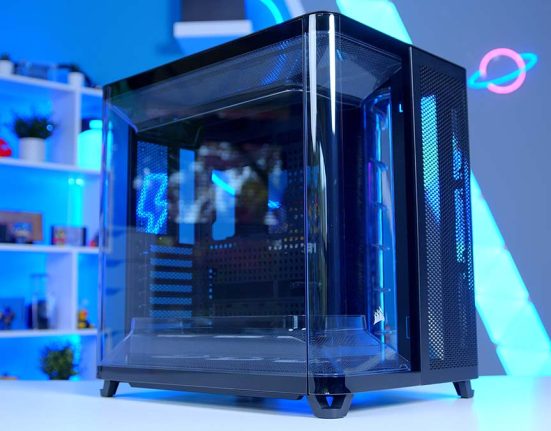We’re at Computex this year in Taipei, Taiwan, looking at all the new PC parts and components that various manufacturers are showcasing. We’re headed to the renowned yellow pirates, Corsair, to look at their product ranges.
Corsair’s main focus this year is their coolers and fans. Still, we’ve also seen some new PC cases, a racing sim, and custom peripherals, similar to Xbox Design Lab. With our Computex coverage, we’ll take a brief look at all of the components on offer, including details about the specs and insight into our thoughts about each product.
Fans & CPU Coolers
Corsair RS ARGB Fans
Since the launch of iCUE LINK, much of Corsair’s focus has been developing this new ecosystem to accommodate those looking to build a cable-free PC. However, at Computex, we got to look at their new RS ARGB fans. These new fan options come at a considerably lower price point than their iCUE LINK counterparts and are also fully compatible with 3-pin and 4-pin RGB standards.

The RS fans come in 120mm and 140mm sizes, bringing more airflow for those who need it. They also work with Corsair iCUE Commander Core hubs, providing a way to control the speeds and RGB effects through Corsair’s iCUE software. These fans can also be paired with the Corsair daisy chain 4-pin PWM cable, making cable management much more straightforward.
Corsair RX MAX Fans
The Corsair RX MAX fans are a new addition to the iCUE LINK ecosystem, but instead of being 25mm thick, which is standard across most fans, these new fans are 30mm thick. The 5mm thickness increase is surprisingly beneficial as it allows for more airflow at any given speed compared to a standard 25mm fan. The thickness also allows the fans to be cranked at higher speeds without adding extra noise. It’s a small change, but it’s impressive nonetheless.

Understandably, as the RX MAX range is part of the iCUE LINK ecosystem, these fans offer vibrant RGB. They can easily be connected to an existing setup through the unique daisy chain method. Each fan is equipped with Corsair’s latest AirGuide blades, which effectively funnel air into a concentrated column instead of spraying it into a cone shape, which is more common with traditional fan blade designs.
iCUE LINK LX Fans
Also joining the iCUE LINK family is a new series of LX fans. These fans are RGB and feature lighting strips around the edge of each fan so that lighting will be visible from almost every angle. The iCUE LINK LX range can easily be connected to an existing setup through the iCUE LINK ecosystem, where up to 24 devices are supported across one hub.
These iCUE LINK LX fans also utilise a magnetic dome bearing and AirGuide blades, similar to their iCUE LINK MAX, QX, and RX counterparts. Each fan also contains a microcontroller unit, which strobes the LEDs in time with the fan speed to create a unique effect that makes the fans look like they aren’t spinning.
iCUE LINK TITAN RX Coolers
Corsair has released some new iCUE LINK coolers that have received a name change and are now known as ‘TITAN RX’ instead of the ‘H###i’ naming scheme. Aside from the name change, the new TITAN coolers have also seen some upgrades in the performance and building steps, along with minor design changes compared to standard iCUE LINK coolers. Regarding the design, the iCUE LINK TITAN coolers use RX fans, which are slightly weaker on the RGB front than the QX fans, which come with standard iCUE LINK AIOs.

The iCUE LINK TITAN RX AIOs also have a new pump and pump cap design. The pump uses a FlowDrive cooling engine with a 3-phase motor, while the cold plate has been improved to ensure the best heat transfer possible. Because of these changes, prospective buyers will see about a 5-degree improvement in thermal performance compared to standard iCUE LINK liquid coolers and lower noise levels due to the improved pump.
Corsair is releasing its TITAN coolers in three sizes, 240mm, 280mm, and 360mm, and they will all be compatible with AM5 and LGA1700 sockets, along with LGA1851, which is the alleged socket being used with Intel’s upcoming Arrow Lake desktop CPUs.
Cases
Corsair 3500 Series
Corsair introduced the 2500 and 6500 series towards the start of 2024, which hit the market with tremendous success. The Corsair 3500 is designed to balance the seamless glass aesthetic and a dual-chamber style while coming in at a highly affordable price.

The 3500 series comes in three variants: the 3500X ARGB, 3500X, and 3500X RGB. The only differences between each variant are the included fans or lack thereof. The 3500X RGB models come with three RGB fans, either addressable or non-addressable, while the standard 3500X does not feature any pre-installed fans. On the specs front, the 3500 series supports 360mm radiators at the top and sides, with space for 120mm AIOs at the bottom and rear. This case can also house up to ten 120mm fans.
| Specification | Corsair 3500X/RGB/ARGB |
|---|---|
| Form Factor | Mid-Tower |
| Motherboard Support | Mini-ITX, Micro-ATX, ATX, E-ATX (Backplane motherboards supported too) |
| Case Dimensions (L x W x H) | 506mm x 460mm x 240mm |
| Front IO | 2 x USB 3.2 Gen1 Type-A 1 x USB 3.2 Gen2 Type-C 1 x Mic/Headphone Jack |
| PCI-E Slots | 7 |
| Colour | Black White |
| Max Clearance | 170mm Cooler Height 410mm GPU Length 180mm PSU Length |
| Drive Support | Up to 2 x 2.5 inch Up to 2 x 3.5 inch |
| Fan Support | Top: 3 x 120mm Side: 3 x 120mm Bottom: 3 x 120mm Rear: 1 x 120mm |
| Radiator Support | Top: Up to 360mm Side: Up to 360mm Bottom: Up to 120mm Rear: Up to 120mm |
| Pre-Installed Fans | 3500X: 0 3500X RGB: 3 x 120mm RGB 3500X ARGB: 3 x 120mm ARGB |
| MSRP | $89 |
The Corsair 3500 range can house E-ATX motherboards and supports reverse connector designs, allowing you to build a cable-free system with the addition of an iCUE LINK cooler. Much like its 2500 and 6500 counterparts, the 3500 range is gorgeous and utilises a panoramic seamless glass view showing off all your components in their glory. At $89, the 3500X is a bargain, and we’re excited to see it drop later this year.
Corsair 9000 Series
Perhaps the most mesmerising inclusion within the enormous scope of products showcased was the new 9000D Airflow chassis. Acting as a successor to the 1000D, the 9000D is a vast case that can support two water-cooled systems simultaneously. The Corsair 9000D is undoubtedly a showpiece and is an ideal chassis for prospective buyers who need two PCs, as this case can house two systems.

At Computex, Corsair fitted out the 9000D with four pump/reservoir combos, a Mini-ITX and E-ATX motherboard with liquid-cooled CPUs and GPUs, 32 iCUE LINK QX fans, and two radiators at the top and front of the case. The Corsair 9000D opens up many options for enthusiasts to build a one-of-a-kind system, which can be made incredibly easy using the iCUE LINK ecosystem, which streamlines cable management, data and power.
| Specification | Corsair 9000D Airflow |
|---|---|
| Form Factor | Mid-Tower |
| Motherboard Support | Mini-ITX, Micro-ATX, ATX, E-ATX (Backplane motherboards supported too) |
| Front IO | 2 x USB 3.2 Gen1 Type-A 1 x USB 3.2 Gen2 Type-C 1 x Mic/Headphone Jack |
| PCI-E Slots | 8 + 2 Vertical |
| Colour | Black White |
| Drive Support | 11 Total |
| Fan Support | Top: 8 x 120mm Front: 8 x 120mm Side: 3 x 120mm Rear: 2 x 120mm |
| Radiator Support | Top: Up to 480mm Front: Up to 480mm Side: Up to 360mm Rear: Up to 240mm |
| Pre-Installed Fans | 3500X: 0 3500X RGB: 3 x 120mm RGB 3500X ARGB: 3 x 120mm ARGB |
| MSRP | $89 |
The Corsair 9000D is a no-compromises case, and as expected, it will likely launch with an enthusiast-level price point. If the Corsair 1000D is anything to go by (a $499.99 case), the 9000D will likely hit the shelves at a similar MSRP. We expect to see this case later in 2024; we recommend watching this space for some insane PC builds with the 9000D!
Racing Sim & Corsair Labs
Corsair Sim Rig
Aside from Corsair’s usual range of products, we also saw their new racing sim setup. With sim racing becoming more popular and accessible to the everyday gamer, it’s no wonder that Corsair has decided to dip its toe into this space. The Corsair Sim Rig has space for an optional bucket seat and can be paired up with a monitor like the XENEON 34WQHD240-C to offer an immersive racing experience.
Corsair’s sim configurator will help you get any existing gear set up and installed on the sim or pick out the right additional parts for those starting fresh. The rig is constructed of 50mm steel tubing, providing excellent stability and sturdiness. It accommodates drivers from 5 feet, anywhere up to 6 feet 6 inches, with minimal tools required.

In addition, Corsair provides optional accessories to customise the sim rig, such as a tray to keep your PC or console dust-free, a drive front mount to secure the wheelbase, mounts for the gear shifter and more. This rig supports VESA mounts for a single monitor up to 49 inches wide, while the upper monitor mount supports sizes up to 34 inches. Alternatively, those with a triple monitor setup must pick up the expansion kit, which supports triple screens up to 55 inches. Corsair hasn’t released much more information beyond this, so stay tuned for more coverage over the coming weeks and months.
Labs
At Computex, Corsair also announced their new labs, which allow gamers to customise their PC gaming peripherals. Not too dissimilar from the Xbox Design Lab, those buying a keyboard, mouse, or mouse pad will be able to change the look of their gaming devices instead of retaining the cheaper but more monotone look.

Before purchasing a product, gamers can click the ‘Start Customizing’ link, which will take them to the Corsair Labs webpage. You can change the colour and internal parts from here and add accessories like a wrist rest. Admittedly, the customisation here is restricted to Corsair’s presets, so there’s not 100% freedom. However, seeing some alternative design options is nice, even if they are a bit pricey. Corsair Custom Labs are now available for those picking up any Corsair peripherals.




![FI_[DP056] Antec flux M + 9060XT](https://geekawhat.com/wp-content/uploads/2025/12/FI_DP056-Antec-flux-M-9060XT-551x431.jpg)

![FI_[DM78] Corsair Air 5400 + 5090 Gaming PC Build](https://geekawhat.com/wp-content/uploads/2025/11/FI_DM78-Corsair-Air-5400-5090-Gaming-PC-Build-551x431.jpg)
![FI_[DP051] Antec C5 + 5070Ti Gaming PC Build](https://geekawhat.com/wp-content/uploads/2025/11/FI_DP051-Antec-C5-5070Ti-Gaming-PC-Build-551x431.jpg)

